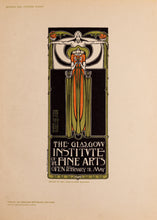Artist: Herbert McNair, Margaret and Frances MacDonald (Scottish)
Title: The Glasgow Institute
Plate: PM. 29
Original lithograph from the "Das Moderne Plakat" series, View entire collection (50)
Printed by Verlag von Gerhard Kuhtmann, Dresden, 1897.
From the rare Deluxe edition printed on Japon of only 40 copies
Presented in 16 x 20 in. acid free, archival museum mat, with framing labels. Ready to frame. Shipped boxed flat.
Certificate of Authenticity.
Plakat Sheet Size: 8 1/2 in x 11 1/4 in 21 cm x 29 cm
Price: Temporarily out of stock
I can usually source this poster. If you are interested please contact me. GregFull size posters by the "Four" are extremely rare and have fetched over $100,000 US in auction. None have been seen on the market for years.
From the rare Deluxe edition printed on Japon of only 40 copies
The deluxe edition of 40 on Japon paper was more valuable as the printing was on a higher quality textured paper which gives the images warmer and enhanced colours.
This brilliant poster designed and produced for The Glasgow Institute of the Fine Arts in 1895. Designed by Herbert McNair of "The Glasgow Four" a group of designers that also included the great Charles Rennie Mackintosh and Margaret and Frances Macdonald. He did this poster along with the Macdonald sisters, Margaret and Frances, his wife. Their controversial poster designs led to "The Four" being termed "The Spook School" by critics.
"While rejecting the term 'stylist,' these four in close association evolved an integrated vocabulary of decorative forms and an overall look that was uniquely their own, despite owing debts to William Morris, Aubrey Beardsley, the Dutch symbolist painter Jan Toorop and Japanese design generally. Eliminating what Charles called 'antiquarian ornament,' they achieved a pared down version of Art Nouveau that paved the way for Art Deco and Modernist Minimalism. A Scottish spirit was infused by means of heathery colors and mystical Celtic symbols.
This innovative quartet teamed up while studying at The Glasgow School of Art (later rebuilt as Charles' architectural masterpiece). English-born but with family in Glasgow, the inseparable Macdonald sisters were enrolled as day students in the early 1890's and the two young men, native Glaswegians associated with the same architectural practice, attended evening classes. Independently, each pair had embarked upon similar experiments in drawing, watercolor painting and decoration. Noting a strong affinity in content, as well as technique and form, the school's astute director introduced them and the creative alliance forged was immediately successful. When their avant-garde 'New Art' appeared at the next student show, it attracted praise and they were christened The Four"(Glasgow style)
"This poster for the Glasgow Institute of the Fine Arts is characteristic of the idiosyncratic visual language that the Macdonald sisters and McNair pioneered. Its muted colors and linear stylizations of human, plant, and bird forms, combined with blocks of irregular lettering, connect it with the Art Nouveau of mainland Europe; the influence of Celtic imagery, however, makes it also a uniquely localized expression. In the early 1890s, the creative talents of the Macdonald sisters and McNair were fostered in the hothouse atmosphere of the Glasgow School of Art, a progressive institution that offered an innovative curriculum and welcomed female students. The sisters set up their own studio as professional designers in 1895, and although neither they nor McNair had any formal training in the design of lithographic posters, they experimented jointly with a series of large-format designs.
By arranging their three names in a vertical column on the poster’s left side, the artists highlighted a collaborative approach in which their individual contributions are often indistinguishable. As McNair later wrote, “It is hard to say how much is the suggestion or influence of the one and how much that of the other.” The posters found favor in progressive arts publications and with European decorative artists and designers, especially the Secessionists in Vienna, but also attracted vehement criticism for what critics called their “ghoul-like” and androgynous representations of the female form, which contradicted conventional ideals of feminine beauty." (moma.org)



